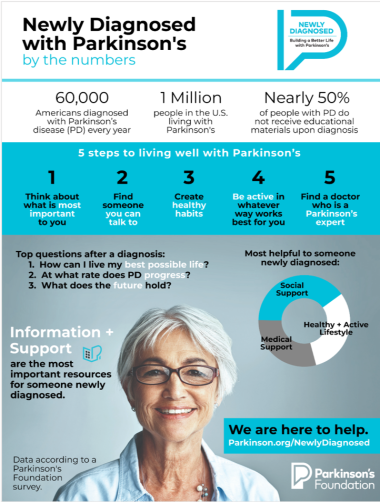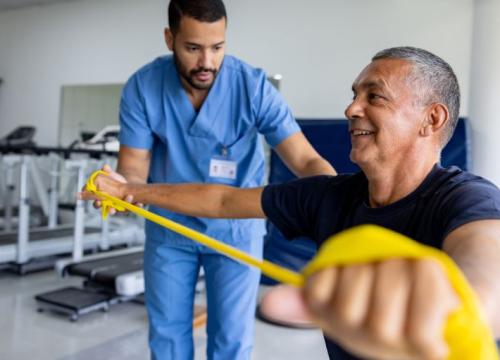Newly Diagnosed: Building a Better Life with Parkinson's

Everyone processes a Parkinson’s disease (PD) diagnosis differently. Navigating a range of emotions — from relief to despair — can feel overwhelming. Built on community, the Parkinson’s Foundation is here to support people newly diagnosed with Parkinson’s and their care partners now and at every stage of their journey.
“Newly Diagnosed: Building a Better Life with Parkinson’s” is the Parkinson’s Foundation campaign working to close the gap between a PD diagnosis and the essential resources that can inspire and support people new to Parkinson’s.
The goal is to help connect those new to the PD community with others living with PD and work toward building a network of support. These five steps can equip people with Parkinson’s with tools that foster well-being while ideally reducing worry and improving day-to-day living.
1. Determine Your Goals
Create an action plan, honor your efforts as you take small steps towards success and don’t be afraid to ask for help. Call the Parkinson’s Foundation Helpline at 1-800-4PD-INFO (473-4636) for answers to all your questions, starting with your diagnosis.
Thinking about what is most meaningful to you, then working it into your daily routine, can be inspiring and empowering. Setting small, clear personal goals — whether designed to boost health or personal connections — and following through, can help you live well. Be sure to reward yourself when you master a goal. This can help inspire you to tackle and conquer your next challenge.
2. Find Someone to Talk to
You are not alone. It’s important to understand how Parkinson’s can impact you physically and how it can impact your mood and emotions. Finding someone to talk to can provide connection, comfort and understanding. A counselor or PD support group can provide opportunities to talk about shared experiences, relieve stress and build new friendships.
Whether you seek out a counselor or join a support group, sharing your feelings can help you navigate them and prevent isolation.

3. Create Healthy Habits
Maintaining good health is vital to living well with Parkinson’s. Everyone with PD should strive for good nutrition and ample sleep. Vegetables, fruits, whole grains, milk and dairy products, protein-rich foods and healthy fats, like olive oil and nuts, can improve energy, fight constipation and keep bones strong. Try planning meals in advance to ensure a healthy diet.
Getting enough sleep helps manage mood, health and PD symptoms. Make sure to keep your sleeping area, cool, dark and free from electronics, to ensure plenty of rest.
4. Be Active
Exercise is essential to managing almost every aspect of Parkinson’s. Steady physical activity can improve many symptoms and offers a neuroprotective effect. It can also improve mood, coordination, flexibility, working memory and more. Moving Day, A Walk for Parkinson’s, is a great way to get active.
The Parkinson’s Outcomes Project shows that people with PD who start exercising earlier and a minimum of 2.5 hours a week, experience a slowed decline in quality of life compared to those who start later. Establishing early exercise habits is essential to overall disease management.
5. Find a Parkinson’s Expert
Working together with a movement disorder specialist or neurologist who specializes in PD ensures you get the best possible care. Neurologists are doctors who work with brain and central nervous system conditions such as PD. Movement disorder specialists — neurologists with additional training to treat people with Parkinson’s at every stage of the disease — can be a key addition to a quality care team.
Your primary Parkinson’s doctor can recommend other healthcare professionals who can help treat day-to-day challenges. When possible, assembling a holistic, care team can optimize your well-being.
To reach more newly diagnosed people, the Parkinson’s Foundation has launched new resources, compiled expert advice and a new online community for people with Parkinson’s, family members and care partners to build a better life with Parkinson’s.
Visit Parkinson.org/NewlyDiagnosed to order or download Newly Diagnosed resources.
Related Blog Posts


Practical Ways to Address Pain in Parkinson's
